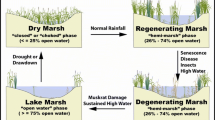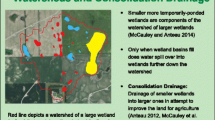Abstract
The objective of the study, which is a component of a comprehensive evaluation of the hydrologic and ecological effects of groundwater pumping from the Kirkwood-Cohansey aquifer, was to apply empirically determined hydrology-vegetation models to develop geographic information system (GIS)-based landscape models for three study basins in the New Jersey Pinelands. The wetland- indicator modeling suggests that the area dominated by wetland species will decline in area with increased groundwater withdrawal due to the predicted drop in water table. While some patterns revealed in the results are reasonably consistent across basins, other changes are a function of the unique topographic form and hydrologic characteristics of a particular basin. The results suggest that cedar and hardwood swamps which are at the wetter end of the water table gradient will show the greatest percent declines in area. The landscape modeling suggests that at the higher levels of groundwater withdrawal the decline of wetland area will be especially severe in the upper headwaters of the basins, and that there will be ‘retreat’ of existing wetlands to a narrower streamside corridor. The landscape modeling also suggests that there will be a change in the broader landscape pattern with a simplification of the wetland mosaic with fewer patches.






Similar content being viewed by others
References
Auble GT, Friedman JM, Scott ML (1994) Relating riparian vegetation to present and future streamflows. Ecological Applications 4:544–554
Bledsoe BP, Shear TH (2000) Vegetation along hydrologic and edaphic gradients in a North Carolina coastal plain creek bottom and implications for restoration. Wetlands 20:126–147
Castelli RM, Chambers JC, Tausch RJ (2000) Soil plant relations along a soil-water gradient in great basin riparian meadows. Wetlands 20:251–66
Charles EG, Nicholson RS (2011) Simulation of Groundwater Flow and Hydrologic Effects of Groundwater Withdrawals in the Pinelands of Southern New Jersey U.S. Geological Survey Scientific Investigations Report 2010 (in preparation).West Trenton, NJ
Cooper DJ, D’Amico DR, Scott ML (2003) Physiological and morphological response patterns of populus deltoides to alluvial groundwater pumping. Environmental Management 31:215–226
Dahl TE, Allord GJ (1996) History of Wetlands in the Conterminous United States. In U.S. Geological Service Water Supply Paper 2425 On-line version http://water.usgs.gov/nwsum/WSP2425/history.html
Dwire KA, Kauffman JB, Brookshire ENJ, Baham JE (2004) Plant biomass and species composition along an environmental gradient in montane riparian meadows. Oecologia 139:309–17
Dwire KA, Kauffman JB, Baham JE (2006) Plant species distribution in relation to water-table depth and soil redox potential in montane riparian meadows. Wetlands 26:131–46
Ellenberg H (1988) Vegetation ecology of Central Europe, 4th edn. Cambridge University Press, Cambridge
ESRI (2010) ArcGIS Dekstop. Release 10. Environmental Systems Research Institute, Redlands
Franklin JF, Forman RTT (1987) Creating landscape patterns by forest cutting: ecological consequences and principles. Landscape Ecology 1:5–18
Franz EH, Bazzaz FA (1977) Simulation of vegetation response to modified hydrologic regimes: a probabilistic model based on niche differentiation in a floodplain forest. Ecology 58:176–183
Gary HL (1963) Root distribution of five-stamen tamarisk, seepwillow, and arrowweed. Forest Science 9:311–314
Hale MG, Orchutt DM (1987) The physiology of plants under stress. Wiley, New York
Hammersmark CT, Rains MC, Wickland AC, Mount JF (2009) Vegetation and water-table relationships in a hydrologically restored riparian meadow. Wetlands 29:785–797
Harbaugh AW, Banta ER, Hill MC, McDonald MG (2000) MODFLOW-2000-the U.S. Geological survey modular ground-water model- user guide to modularization concepts and the ground-water flow process: U.S. Geological Survey Open-File Report 00–92, 121 p., accessed January 13, 2010 at http://water.usgs.gov/nrp/gwsoftware/modflow2000/ofr00-92.pdf
Horton JL, Kolb TE, Hart SC (2001) Physiological response to groundwater depth varies among species and with river flow regulation. Ecological Applications 11:1046–1059
Hosmer DW, Lemeshow S (2000) Applied logistic regression, 2nd edn. Wiley, New York
Kentula ME (1996) Wetland restoration and creation. In Fretwell JD, Williams JS, Redman PJ (eds), National water summary of wetland resources, pages 87–92. U.S. Geological Survey Water-Supply Paper 2425. U.S. Government Printing Office, Washington, D.C., USA
Laidig KJ, Zampella RA (2009) Hydrologic regimes associated with Helonias bullata L. (swamp pink) and the potential impact of simulated water-level reductions. Journal of the Torrey Botanical Society 136:221–232
Laidig KJ, Zampella RA, Brown AM, Procopio NA (2010a) Development of vegetation models to predict the potential effect of groundwater withdrawals on forested wetlands. Wetlands 30:489–500
Laidig KJ, Zampella RA, Brown AM, Procopio NA (2010b) Development of vegetation models to predict the potential effect of groundwater withdrawals on forested wetlands. Pinelands Commission, New Lisbon, New Jersey, USA, 30 p., available at http://www.state.nj.us/pinelands/science/pub/KC%20Palustrine%20Final%20Report.pdf
Loheide SP, Gorelick SM (2007) Riparian hydroecology: a coupled model of the observed interactions between groundwater flow and meadow vegetation patterning. Water Resources Research 43:W07414. doi:10.1029/2006WR005233
McGarigal K, Cushman SA, Neel MC, Ene E (2002) FRAGSTATS: spatial pattern analysis program for categorical maps. Computer software program produced by the authors at the University of Massachusetts, Amherst. Available at the following web site: www.umass.edu/landeco/research/fragstats/fragstats.html
Meixner FX, Eugster W (1999) Effects of landscape pattern and topography on the emissions and transport. In: Tenhunen JD, Kabat P (eds) Integrating hydrology, ecosystem dynamics and biogeochemistry in complex landscapes. Wiley, New York, pp 147–175
Mitsch WJ, Gosselink JG (2000) Wetlands, 3rd edn. Wiley, New York
Mountford JO, Chapman JM (1993) Water regime requirement of British wetland vegetation: using the moisture classification of Ellenberg and Londo. Journal of Environmental Management 38:275–288
Munoz-Reinoso JC (2001) Vegetation changes and groundwater abstraction in SW Donana, Spain. Journal of Hydrology 242:197–209
Munoz-Reinoso JC, Garcia-Novo F (2005) Multiscale control of vegetation patterns: the case of Doñana (SW Spain). Landscape Ecology 20:51–61
Obedzinski RA, Shaw CG III, Neary DG (2001) Declining woody vegetation in riparian ecosystems of the western United States. Western Journal of Applied Forestry 16:169–181
Pickett STA, White PS (1985) The ecology of natural disturbance and patch dynamics. Academic, Orlando
Preston EM, Bedford BL (1988) Evaluating cumulative effects on wetland functions: a conceptual overview and generic framework. Environmental Management 12:565–583
Rhodehamel EC (1979) Hydrology of the New Jersey Pine Barrens. In: Forman RTT (ed) Pine Barrens: ecosystem and landscape. Academic, New York, pp 147–167
Rodriguez-Iturbe I, Porporato A (2005) Ecohydrology of water-controlled ecosystems: Soil moisture and plant dynamics. Cambridge Univ. Press, Cambridge
Roman CT, Zampella RA, Jaworsksi AZ (1985) Wetland boundaries in the New Jersey Pinelands: ecological relationships and delineation. Water Resources Bulletin 21:1005–1011
Scott ML, Shafroth PB, Auble GT (1999) Responses of riparian cottonwoods to alluvial water table declines. Environmental Management 23:347–358
Shafroth PB, Stromberg JC, Patten DT (2000) Woody riparian vegetation response to different alluvial water-table regimes. Western North American Naturalist 60:66–76
Stromberg JC, Tiller R, Richter B (1996) Effects of groundwater decline on riparian vegetation of semiarid regions: the San Pedro, Arizona. Ecological Applications 6:113–31
Toner M, Keddy P (1997) River hydrology and riparian wetlands: a predictive model for ecological assembly. Ecological Applications 7:236–246
U.S. Environmental Protection Agency and U.S. Department of Agriculture (1998) Clean water action plan: restoring and protecting America’s waters. National Center for Environmental Publications and Information, Cincinnati
U.S. Fish and Wildlife Service (1988) National list of vascular plant species that occur in wetlands. U.S. Fish & Wildlife Service Biological Report 88 (26.9)
Walker RL, Reilly PA, Watson KM (2008) Hydrogeologic framework in three drainage basins in the New Jersey Pinelands, 2004–06: U.S. Geological Survey Scientific Investigations Report 2008–5061.West Trenton, NJ
Wiens J (2002) Riverine landscapes: taking landscape ecology into the water. Freshwater Biology 47:501–515
Williams CA, Cooper DJ (2005) Mechanisms of riparian cottonwood decline along regulated rivers. Ecosystems 8:382–395
Winter TC (1988) A conceptual framework for assessing cumulative impacts on the hydrology of nontidal wetlands. Environmental Management 12:605–620
Yang J, Dilts TE, Condon LA, Turner PL, Weisberg PJ (2011) Longitudinal-and Transverse-scale Environmental Influences on Riparian Vegetation across Multiple Levels of Ecological Organization. Landscape Ecology 26:381–395
Zapecza OS (1989) Hydrogeologic framework of the New Jersey Coastal Plain. U.S. Geological Survey Professional Paper 1404-B
Acknowledgments
Funding for this study was provided through the Water Supply Fund in accordance with New Jersey Public Law 2001, Chapter 165. We gratefully acknowledge the close collaboration with the various project partners at the Pinelands Commission, including Kim Laidig, Allison Brown, Robert Zampella, John Bunnell, Nick Procopio, and at the U.S. Geological Survey Water Resources Center including Robert Nicholson and Manny Charles.
Author information
Authors and Affiliations
Corresponding author
Electronic Supplementary Material
Below is the link to the electronic supplementary material.
ESM 1
(PDF 98 kb)
Rights and permissions
About this article
Cite this article
Zhang, Y., Miao, Z., Bognar, J. et al. Landscape Scale Modeling of the Potential Effect of Groundwater-level Declines on Forested Wetlands in the New Jersey Pinelands. Wetlands 31, 1131–1142 (2011). https://doi.org/10.1007/s13157-011-0223-2
Received:
Accepted:
Published:
Issue Date:
DOI: https://doi.org/10.1007/s13157-011-0223-2




